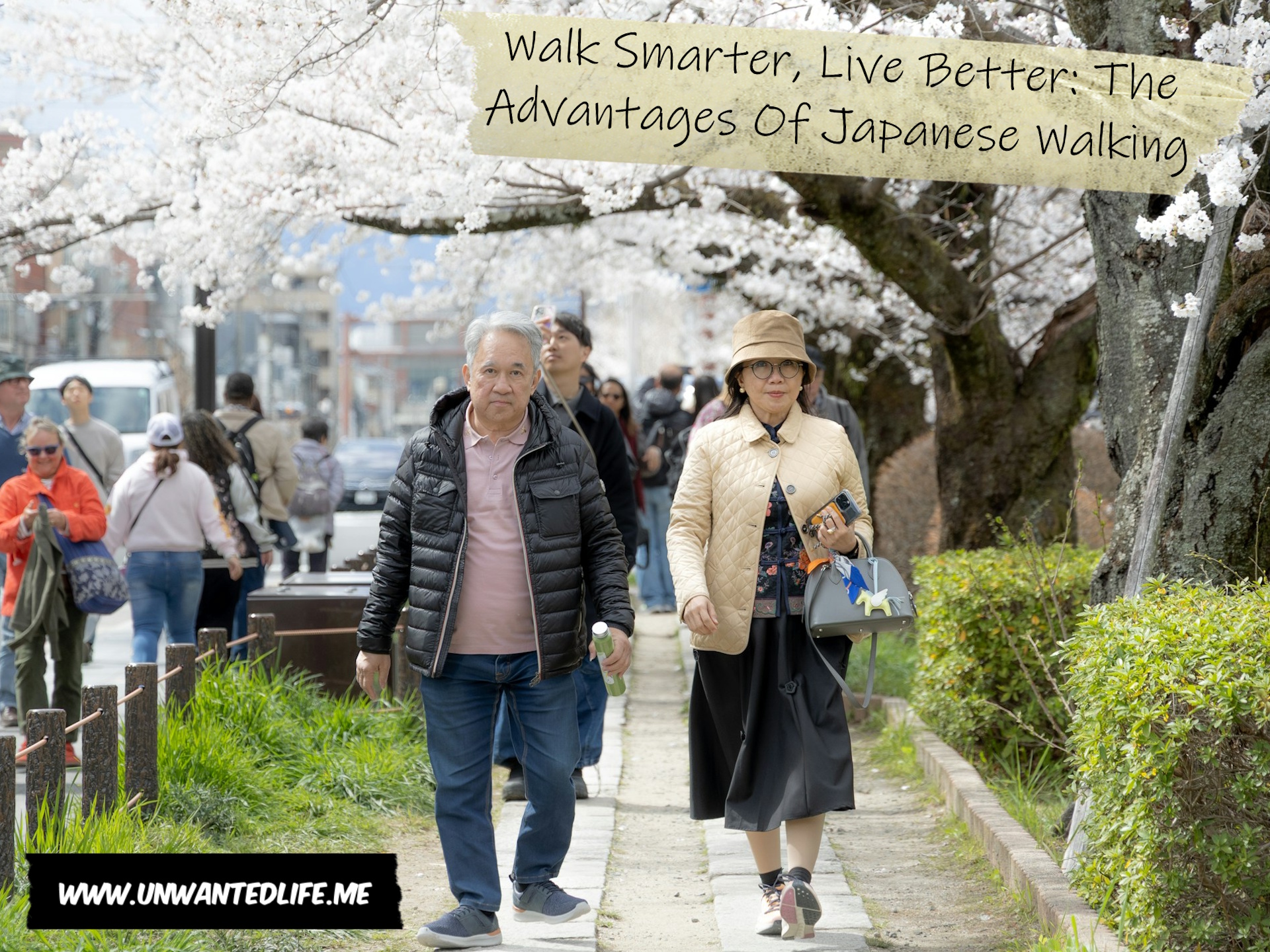I noticed recently that people are talking about Japanese walking, which piqued my interest. I wanted to know what it was all about, and if this was all hot air or something that might really help people with their health. This article is a result of what I found out.
What Is Japanese Walking
The Japanese walking method, also referred to as interval walking or the 3-3 walking workout, is a science-backed exercise protocol developed by Japanese researchers, Professor Hiroshi Nose and Associate Professor Shizue Masuki at Shinshu University in Matsumoto, Japan (Glover, 2025).
The Japanese walking method consists of alternating between periods of brisk walking and slow walking. The most common protocol is to walk fast for three minutes at 70% of aerobic capacity, followed by three minutes of slow walking at 40% of aerobic capacity (Yoshimoto et al., 2022). This cycle is usually repeated five times for a total of a 30-minute walking workout.
Japanese Walking Vs. 10,000 Steps
When it comes to the 10,000 steps that have ingrained themselves into society, this benchmark wasn’t rooted in science, but marketing (Yates, 2025). The 10,000 steps benchmark dates back to the 1964 Tokyo Olympic Games, where a company used it to market their new pedometer (Hammond, 2022).
However, since then, research has kind of supported the 10,000 steps claims. A study by Lee et al. (2019), involving 16,741 women with a mean age of 72, participated in a step walking challenge. At a 4.3-year follow-up, the participants who averaged 4,400 steps a day had a significantly lower mortality rate compared to those only doing 2,700 steps a day. Mortality rates continued to decrease until they plateaued at 7,500 steps a day. This would make 7,500 steps a day the magic number, not 10,000.
The fact that 7,500 steps is the real benchmark, and not the 10,000 steps a day, is good news for people undertaking the 10,000 steps a day challenge. Many people have struggled to fit 10,000 steps in a day, because life doesn’t always give us the time to do so, even when walking to and from work, and walking on our lunch breaks (Glover, 2025).
Someone trying to walk 10,000 steps a day will have to find, on average, 70 to 100 minutes in the day to complete that goal (Gutman and Neudecker, 2025). Whereas, with the Japanese walking method, you only need 30 minutes, making it far easier to find time for it. Making Japanese walking more attainable.

If that’s not enough of an incentive, then although the much lower 7,500 steps is more manageable than aiming for 10,000 steps a day, this is still a daily challenge. Whereas, with Japanese walking, we only have to do this four days a week (Yoshimoto et al., 2022).
This HIIT approach to walking means that it will activate more muscle fibres, particularly in the thighs and glutes. This helps manage mobility, balance, and reduces age-related decline. It can also support bone health.
Whereas, a leisurely stroll of 10,000 steps (or 7,500) doesn’t challenge the muscles and bones in the same way, leading to significantly fewer benefits.
This is supported by a study by Nemoto, Gen-no, Masuki, Okazaki, and Nose (2007), who investigated the Japanese walking method. In doing so, they used moderate-intensity continuous walking (8,000 steps) and no walking as controls. They found that interval walking may protect against age-associated increases in blood pressure, have the best increases in isometric knee extension and isometric knee flexion, and protect against decreases in thigh muscle strength and peak aerobic capacity.
Also, a review by Karstoft et al. (2024) concluded that the health benefits of Japanese walking were well established for healthy individuals and those with metabolic diseases.
Interestingly, it’s been suggested that the rhythmic nature of Japanese walking and the mental focus it requires can create a meditative state. I’m not sure if I believe that, but if you’ve experienced this, please let me know in the comments section at the end of this article.
Summary
Any increase in physical activity is beneficial. However, the Japanese walking method is considered better for our health because aiming for 10,000 steps a day can set us up to fail. Plus, intensity matters more than plain volume, which the Japanese walking method incorporates. The physiological challenge this allows for helps lead to more robust improvements in cardiovascular health, muscle strength, and metabolic function in a more time-efficient manner.
Thus, for optimal health, incorporating the intensity that Japanese walking offers is generally more effective than focusing solely on a step count. You can also think of it as exercise snacking.
Ultimately, though, pick what works best for us. If a 30-minute HIIT-based walking approach works for us, then do that. But if a more leisurely walk of 7,500 steps is more our thing, then do that instead. A part of sticking to such routines is finding the best methods that suit us on an individual level, because that makes it easier to achieve our goals.
As always, leave your feedback in the comments section below. Also, please share your experiences with walking and Japanese walking in the comments section below as well. Don’t forget, if you want to stay up-to-date with my blog, you can sign up for my newsletter below. Alternatively, click the red bell icon in the bottom right corner to get push notifications for new articles.
Lastly, if you’d like to support my blog, please find the PayPal and Ko-fi donation payment options below. Until next time, Unwanted Life readers.
References
Glover, A. (2025, June). I swapped 10,000 steps a day for 30 minutes of “Japanese walking” – I’ve never been more active. HuffPost UK. Retrieved from https://www.huffingtonpost.co.uk/entry/japanese-walking-benefits_uk_6850071be4b03c462a058327.
Gutman, A., & Neudecker, K. (2025, February). How long you’ll need to walk 10,000 steps. Men’s Health. Retrieved from https://www.menshealth.com/uk/health/a62901829/how-long-to-walk-10000-steps.
Hammond, C. (2022, February). Do we need to walk 10,000 steps a day?. BBC Future. Retrieved from https://www.bbc.co.uk/future/article/20190723-10000-steps-a-day-the-right-amount.
Lee, I. M., Shiroma, E. J., Kamada, M., Bassett, D. R., Matthews, C. E., & Buring, J. E. (2019). Association of step volume and intensity with all-cause mortality in older women. JAMA Internal Medicine, 179(8), 1105-1112. Retrieved from https://jamanetwork.com/journals/jamainternalmedicine/fullarticle/2734709.
Karstoft, K., Thorsen, I. K., Nielsen, J. S., Solomon, T. P. J., Masuki, S., Nose, H., & Ried-Larsen, M. (2024). Health benefits of interval walking training. Applied Physiology, Nutrition, and Metabolism, 49(7), 1002-1007. Retrieved from https://cdnsciencepub.com/doi/pdf/10.1139/apnm-2023-0595 and https://pubmed.ncbi.nlm.nih.gov/38507778.
Nemoto, K., Gen-no, H., Masuki, S., Okazaki, K., & Nose, H. (2007). Effects of high-intensity interval walking training on physical fitness and blood pressure in middle-aged and older people. Mayo Clinic proceedings, 82(7), 803–811. Retrieved from https://doi.org/10.4065/82.7.803 and https://core.ac.uk/reader/148769277.
Yates, T. E. (2025, June). New research suggests the magic of 10,000 steps a day is a myth. The Independent. Retrieved from https://www.independent.co.uk/life-style/health-and-families/walking-10000-steps-a-day-good-health-benefits-b2770397.html.
Yoshimoto, T., Hasegawa, Y., Furihata, M., Yoshihara, A., Shiramizu, M., Sta. Maria, M. T., Hori, S., Morikawa, M., Marito, P., Kaneko, N., Nohno, K., Nose, H., Masuki, S., & Ono, T. (2022). Effects of interval walking training on oral health status in middle-aged and older adults: a case-control study. International Journal of Environmental Research and Public Health, 19(21), 14465. Retrieved from https://www.mdpi.com/1660-4601/19/21/14465.









